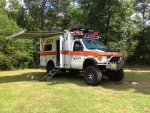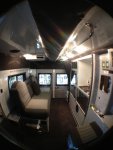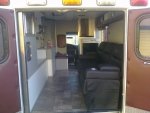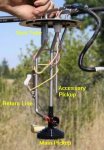flightcancled
Explorer
Following a request from other users I am going to attempt to create a resource for those toying with the idea of starting their own ambulance build.



Why an ambulance?
While there are many reasons like increased head height, large amounts of storage space, quality construction, built in upgrades and features which come standard, savings relative to buying a Sportsmobile/Earthroamer/Unimog, ultimately every builder has found his/her own why this is a good idea. Ambulances are built based on government mandated guidelines focused on safety and functionality. This means that "box" ambulances have an over-engineered aluminum frame and skin which is extremely strong when compared to a fiberglass camper. The strong frame means that the roof is strong enough to mount heavy equipment, or support multiple people's weight. Sections of the box can be removed to add height to the roof, or "bob" the tail for increased clearance. Ambulances are outfitted with higher output alternators, larger battery banks, and power inverters, and idle speed controllers to generate large amounts of on demand power. Additionally a shore power system allows the unit to to be plugged in to provide power to internal outlets, rear thermostat controlled heat and AC, interior lighting, and battery chargers. For those seeking to run a Waste Vegetable Oil system, optional equipment can include dual fuel tanks. Air ride suspension systems are also not an uncommon feature.

What types of Ambulances are there to choose from?
Type 1- A truck based ambulance with an aluminum box
Type 2- A van based ambulance. Typically included is a high-top roof cap.
Type 3- A cut-away van based ambulance with an aluminum box.
Type 3 MiniMod- A smaller type 3. Easiest identified by the front, the edge of the cab sits nearly flush with the side of the box whereas a standard box has an extra 18" or so. These boxes are smaller, lighter, and often come standard with a single rear wheel axle as opposed to a dual rear wheel setup.
Freightliner Ambulance- a much larger ambulance box built on a freightliner platform.


What should I look for when picking out an ambulance?
Typically builders look for a post 1992 Ford E350 or E450 with a 7.3L diesel engine. The Powerstroke 7.3 is preferred for the additional power, turbo, more available parts, and ability to install performance chips and controllers, while idi engines are known for simplicity and reliability. Mileage for these units will typically be high relative to a car, however the 7.3 is known for extremely long life. Usually builders buy units with 65-100k miles on them.
In addition to mileage perspective buyers should be aware that there will be an hours counter somewhere in the unit that should be checked. Many ambulances are required to remain running at all times when not docked at the station, so checking the hours counter is a crucial way to gauge the amount of use the vehicle has seen.
Why these E-Series vans? They are compatible for a 4x4 conversion by U-Joint Offroad and are easy to find parts for.
What should I expect to spend? Depending on the unit probably $3,000-6,500. Already converted 4x4 units will be more expensive.
Things to look for:
Every ambulance is built to the specifications of a client, therefore there are many different options which may or may not be in any unit.
Dual alternators, rear airbag suspension, recent replacement of the engine or transmission, on board compressor or generator, house battery system, reach through access into exterior compartments, locking paddle handles on exterior compartments, room in the cab to allow the seats to tilt back.
How well insulated the box is is also a factor, anything is possible from nothing to 3" of fiberglass bat insulation. Usually this can be checked by removing a light in the ceiling.
Things to stay away from:
Units which have been "decommissioned." Prior to a private individual taking ownership of an emergency unit the siren and flashing lights have to be deactivated. While this can be as simple as pulling a fuse or a wire from the breaker board, this term usually means that the company has stripped the ambulance of anything they think may be handy in the future. Typically this involves a mess of hacked wiring, damaged interior panels, and general haphazard and sloppy work. Usually departments take the things which are most expensive like the inverter, charger, power source, and lighting. To decommission the ambulance yourself so you can get it home simply pull the fuses to the siren and flashers, apply masking tape over the word "Ambulance" as it appears on the exterior, and over any red or blue exterior lights.
Most units have "walk-through" access from the cab into the box. This often includes some form of sliding door or partition. In some cases the client asks the upfitter to make the unit a "reach-through" meaning that there is only a small window in the front wall of the box. It is important to note that the ambulance box is a pre-constructed unit which is modified to fit the client needs and can therefore be returned to a walk-through without damaging the structure of the box, however this may be an unwanted hassle for some builders.
Pay careful attention to the paint. In many cases units have changed hands between companies and have been repainted. Some times paint has been applied over striping, or stripes which are just vinyl and will be removed are covering older stripes, etc.
While the aluminum box wont rust, be sure to lift up the carpet in the cab, and inspect the wheel wells and frame.

What are some of the pitfalls for owning an Ambulance?
In more or less the order you will have to tackle them:
Storage: The ambulance itself requires about a 20'x8' parking space. If you are subject to a Home Owners Association find out if you can park your rig at home.
Insurance and Registration: Because the manufacturer listed weight of a Type 1 or 2 Ambulance is between 10,000-11,500 lbs it will be considered a commercial vehicle. Also you may find that your insurance company has a max weight cut-off. Depending on how far off you are you may be able to gut the van and drive it across the scales at just under, or simply switch companies. Personally I switched to Gieco without issues. Check with your home state to see what the scale requirements are. In some cases a combined weight is required, and a typical CAT scale which shows the weight on each axel is not acceptable. While you are there check to see what the definitions for a "Home on Wheels" and a "Camper" are to see if you can legally convert your vehicle to save yourself money and headaches.
So how does one "build" an ambulance anyway?
Generally builds fall into two categories: full gut an rebuild of the interior, and partial demo/modification.
Partial demo and modification is more common for a number of reasons, first it requires less time/materials/money/skill, and second the build quality of the units is typically quite good. Typical layout for an ambulance is a series of cabinets and counters on the driver side and a bench on the passenger side. All partial builders focus on removing the bench side and rebuilding it with a bed of some sort, and typically re-purpose the driver side.
Fully gutting the interior to the frame allows the builder to do a number of things which aren't otherwise possible like reducing the interior wiring to just the necessary circuits, opening up the front wall to expose the rear of the cab, fully insulate the box, eliminate wasted space and unnecessary compartments, remove unneeded heating or cooling systems, and create new compartments and amenities to fit. Fully gutting the box also allows builders to work in relative freedom without having to protect finish surfaces.
Tips and tricks
Save your trim! Most units come with expensive and durable aluminum trim on everything. This stuff is hard to come by and is very useful. Padded trim is also easy to damage, but a very nice feature which can be re-purposed and reused.
Most builders who don't immediately gut their box are quickly frustrated by the difficulties of running new wiring or accessing the frame to fasten bolts because they are blocked by the interior finishing surfaces. All the compartments are generally pre-built and fastened to the frame using bolts and self-tapping screws. With patience and care they can be removed and replaced without damage. Plan ahead and make any upgrades or changes while you have an exposed an area. Before closing up any area pack as much insulation in as possible.
Through bolting through the box frame from the exterior can become a nightmare if locations are not planned well. Putting bolts in areas were they accessible from interior or exterior light holes makes the tightening process much easier.
Because ambulances can have up to 2,500 individual wires, upfitters are meticulous about color coding and organizing wiring. Units which have labeled wires denoting which circuit they belong to are especially helpful. Wiring will usually originate from a central fuse box or control board with connections to the cab switch panel, a box switch panel, and will be controlled by a Modular Disconnect which turns power to the box functions on and off. Wires typically run in designated chases along the center of the ceiling, and the top corners.

Examples of previous builds:
The Ute
The build that started a trend. A 4x4 conversion and partial gut build of a Mini-Mod.
MegAmbo
No real build thread for this, but an impressive 4x4 Mini-Mod.
AmboVan
A massively impressive 4x4 conversion, raised roof and full gut build of a full size type 3.
Ken's Build
Starting from a cab and chassis for a Type 3, converting to single rear wheel 37" Hummer Tires and adding a Mini-Mod Box.
Ambuland
Full gut, installation of a waste vegitable oil system, full electrical rebuild, and future 4x4 conversion.
Belafonte
Partial interior rebuild and 4x4 conversion.
Zombulance
Raised roof, 4x4 converstion, and full gut.
Black Friday
My personal semi-gut build of an extended and raised cab Type III. Converted to a walk through, added house batteries, updated electrical system, etc. Worth a read because if this hapless idiot can do it so can anyone else.
AMBOT
Lifted and 4x4, raised roof, interior partial gut.
Ozrockrat's Freightliner Ambulance Build
F-Series 4x4 Build

Helpful Links:
Ambulance Parts

A peak into Ambulance Box construction.
If you have any questions, additions or if I missed something please post!



Why an ambulance?
While there are many reasons like increased head height, large amounts of storage space, quality construction, built in upgrades and features which come standard, savings relative to buying a Sportsmobile/Earthroamer/Unimog, ultimately every builder has found his/her own why this is a good idea. Ambulances are built based on government mandated guidelines focused on safety and functionality. This means that "box" ambulances have an over-engineered aluminum frame and skin which is extremely strong when compared to a fiberglass camper. The strong frame means that the roof is strong enough to mount heavy equipment, or support multiple people's weight. Sections of the box can be removed to add height to the roof, or "bob" the tail for increased clearance. Ambulances are outfitted with higher output alternators, larger battery banks, and power inverters, and idle speed controllers to generate large amounts of on demand power. Additionally a shore power system allows the unit to to be plugged in to provide power to internal outlets, rear thermostat controlled heat and AC, interior lighting, and battery chargers. For those seeking to run a Waste Vegetable Oil system, optional equipment can include dual fuel tanks. Air ride suspension systems are also not an uncommon feature.

What types of Ambulances are there to choose from?
Type 1- A truck based ambulance with an aluminum box
Type 2- A van based ambulance. Typically included is a high-top roof cap.
Type 3- A cut-away van based ambulance with an aluminum box.
Type 3 MiniMod- A smaller type 3. Easiest identified by the front, the edge of the cab sits nearly flush with the side of the box whereas a standard box has an extra 18" or so. These boxes are smaller, lighter, and often come standard with a single rear wheel axle as opposed to a dual rear wheel setup.
Freightliner Ambulance- a much larger ambulance box built on a freightliner platform.


What should I look for when picking out an ambulance?
Typically builders look for a post 1992 Ford E350 or E450 with a 7.3L diesel engine. The Powerstroke 7.3 is preferred for the additional power, turbo, more available parts, and ability to install performance chips and controllers, while idi engines are known for simplicity and reliability. Mileage for these units will typically be high relative to a car, however the 7.3 is known for extremely long life. Usually builders buy units with 65-100k miles on them.
In addition to mileage perspective buyers should be aware that there will be an hours counter somewhere in the unit that should be checked. Many ambulances are required to remain running at all times when not docked at the station, so checking the hours counter is a crucial way to gauge the amount of use the vehicle has seen.
Why these E-Series vans? They are compatible for a 4x4 conversion by U-Joint Offroad and are easy to find parts for.
What should I expect to spend? Depending on the unit probably $3,000-6,500. Already converted 4x4 units will be more expensive.
Things to look for:
Every ambulance is built to the specifications of a client, therefore there are many different options which may or may not be in any unit.
Dual alternators, rear airbag suspension, recent replacement of the engine or transmission, on board compressor or generator, house battery system, reach through access into exterior compartments, locking paddle handles on exterior compartments, room in the cab to allow the seats to tilt back.
How well insulated the box is is also a factor, anything is possible from nothing to 3" of fiberglass bat insulation. Usually this can be checked by removing a light in the ceiling.
Things to stay away from:
Units which have been "decommissioned." Prior to a private individual taking ownership of an emergency unit the siren and flashing lights have to be deactivated. While this can be as simple as pulling a fuse or a wire from the breaker board, this term usually means that the company has stripped the ambulance of anything they think may be handy in the future. Typically this involves a mess of hacked wiring, damaged interior panels, and general haphazard and sloppy work. Usually departments take the things which are most expensive like the inverter, charger, power source, and lighting. To decommission the ambulance yourself so you can get it home simply pull the fuses to the siren and flashers, apply masking tape over the word "Ambulance" as it appears on the exterior, and over any red or blue exterior lights.
Most units have "walk-through" access from the cab into the box. This often includes some form of sliding door or partition. In some cases the client asks the upfitter to make the unit a "reach-through" meaning that there is only a small window in the front wall of the box. It is important to note that the ambulance box is a pre-constructed unit which is modified to fit the client needs and can therefore be returned to a walk-through without damaging the structure of the box, however this may be an unwanted hassle for some builders.
Pay careful attention to the paint. In many cases units have changed hands between companies and have been repainted. Some times paint has been applied over striping, or stripes which are just vinyl and will be removed are covering older stripes, etc.
While the aluminum box wont rust, be sure to lift up the carpet in the cab, and inspect the wheel wells and frame.

What are some of the pitfalls for owning an Ambulance?
In more or less the order you will have to tackle them:
Storage: The ambulance itself requires about a 20'x8' parking space. If you are subject to a Home Owners Association find out if you can park your rig at home.
Insurance and Registration: Because the manufacturer listed weight of a Type 1 or 2 Ambulance is between 10,000-11,500 lbs it will be considered a commercial vehicle. Also you may find that your insurance company has a max weight cut-off. Depending on how far off you are you may be able to gut the van and drive it across the scales at just under, or simply switch companies. Personally I switched to Gieco without issues. Check with your home state to see what the scale requirements are. In some cases a combined weight is required, and a typical CAT scale which shows the weight on each axel is not acceptable. While you are there check to see what the definitions for a "Home on Wheels" and a "Camper" are to see if you can legally convert your vehicle to save yourself money and headaches.
So how does one "build" an ambulance anyway?
Generally builds fall into two categories: full gut an rebuild of the interior, and partial demo/modification.
Partial demo and modification is more common for a number of reasons, first it requires less time/materials/money/skill, and second the build quality of the units is typically quite good. Typical layout for an ambulance is a series of cabinets and counters on the driver side and a bench on the passenger side. All partial builders focus on removing the bench side and rebuilding it with a bed of some sort, and typically re-purpose the driver side.
Fully gutting the interior to the frame allows the builder to do a number of things which aren't otherwise possible like reducing the interior wiring to just the necessary circuits, opening up the front wall to expose the rear of the cab, fully insulate the box, eliminate wasted space and unnecessary compartments, remove unneeded heating or cooling systems, and create new compartments and amenities to fit. Fully gutting the box also allows builders to work in relative freedom without having to protect finish surfaces.
Tips and tricks
Save your trim! Most units come with expensive and durable aluminum trim on everything. This stuff is hard to come by and is very useful. Padded trim is also easy to damage, but a very nice feature which can be re-purposed and reused.
Most builders who don't immediately gut their box are quickly frustrated by the difficulties of running new wiring or accessing the frame to fasten bolts because they are blocked by the interior finishing surfaces. All the compartments are generally pre-built and fastened to the frame using bolts and self-tapping screws. With patience and care they can be removed and replaced without damage. Plan ahead and make any upgrades or changes while you have an exposed an area. Before closing up any area pack as much insulation in as possible.
Through bolting through the box frame from the exterior can become a nightmare if locations are not planned well. Putting bolts in areas were they accessible from interior or exterior light holes makes the tightening process much easier.
Because ambulances can have up to 2,500 individual wires, upfitters are meticulous about color coding and organizing wiring. Units which have labeled wires denoting which circuit they belong to are especially helpful. Wiring will usually originate from a central fuse box or control board with connections to the cab switch panel, a box switch panel, and will be controlled by a Modular Disconnect which turns power to the box functions on and off. Wires typically run in designated chases along the center of the ceiling, and the top corners.

Examples of previous builds:
The Ute
The build that started a trend. A 4x4 conversion and partial gut build of a Mini-Mod.
MegAmbo
No real build thread for this, but an impressive 4x4 Mini-Mod.
AmboVan
A massively impressive 4x4 conversion, raised roof and full gut build of a full size type 3.
Ken's Build
Starting from a cab and chassis for a Type 3, converting to single rear wheel 37" Hummer Tires and adding a Mini-Mod Box.
Ambuland
Full gut, installation of a waste vegitable oil system, full electrical rebuild, and future 4x4 conversion.
Belafonte
Partial interior rebuild and 4x4 conversion.
Zombulance
Raised roof, 4x4 converstion, and full gut.
Black Friday
My personal semi-gut build of an extended and raised cab Type III. Converted to a walk through, added house batteries, updated electrical system, etc. Worth a read because if this hapless idiot can do it so can anyone else.
AMBOT
Lifted and 4x4, raised roof, interior partial gut.
Ozrockrat's Freightliner Ambulance Build
F-Series 4x4 Build

Helpful Links:
Ambulance Parts

A peak into Ambulance Box construction.
If you have any questions, additions or if I missed something please post!
Last edited:






